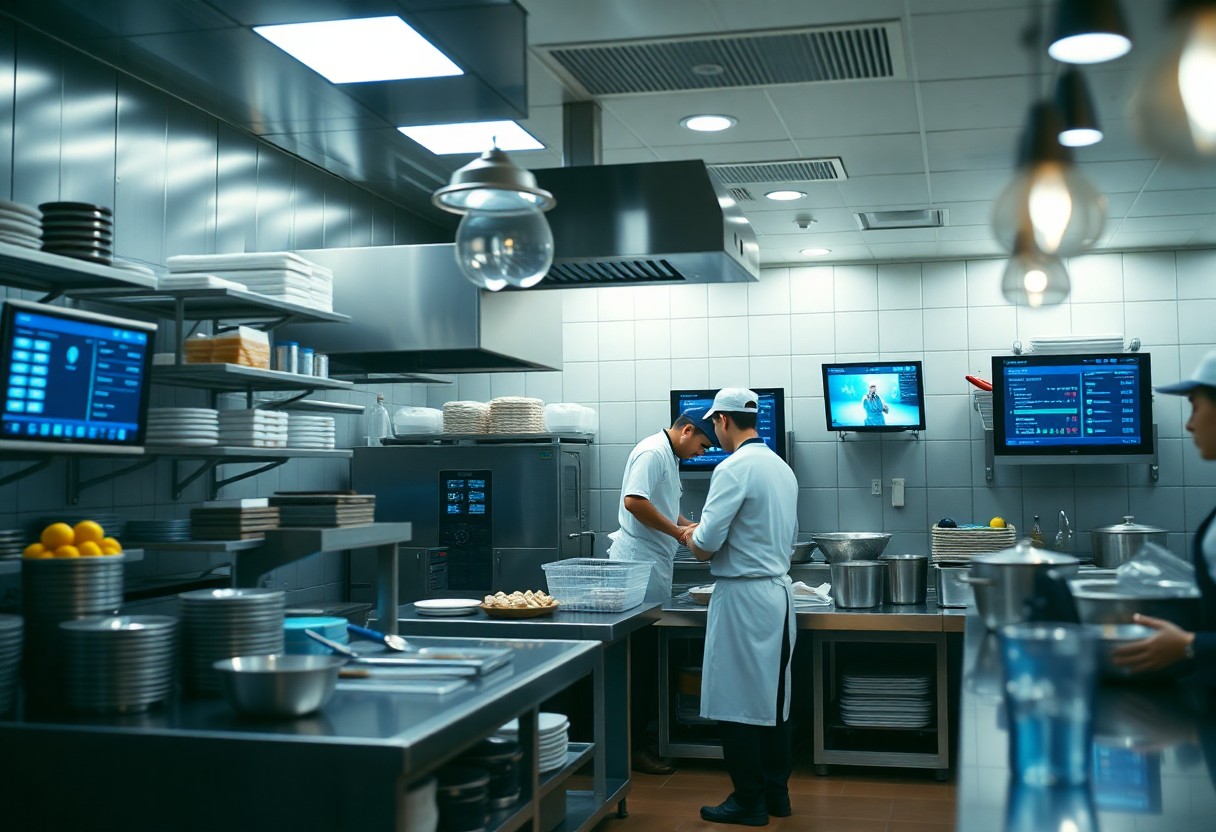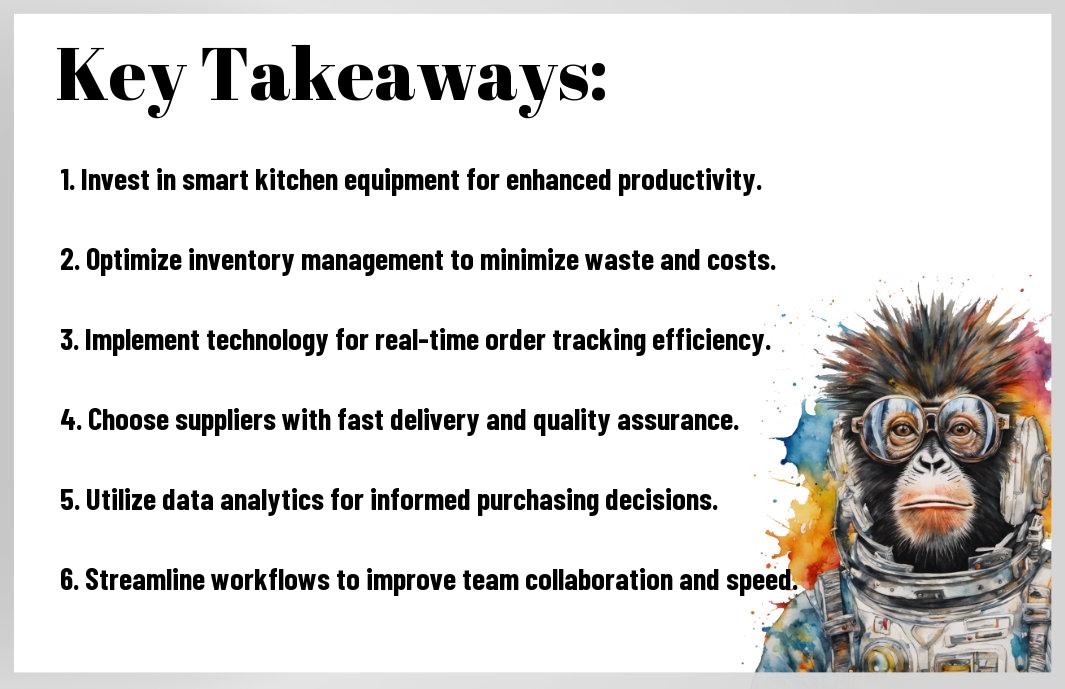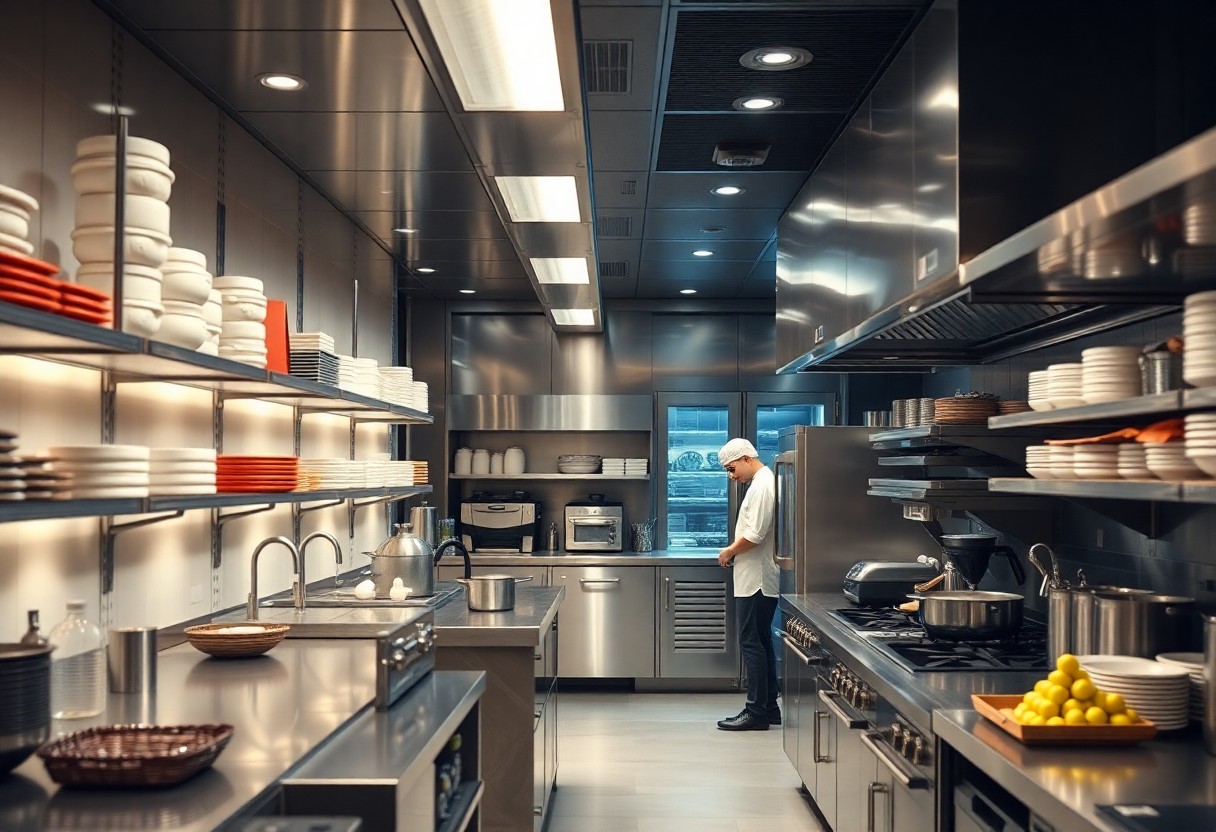Over time, your restaurant’s success depends on how well you manage your kitchen operations. By selecting the right smart restaurant supplies, you can significantly boost efficiency, reduce costs, and streamline your processes. This blog post will guide you through making informed choices that lead to a smoother and more profitable kitchen experience, giving you the tools to stay ahead in a competitive industry.

Key Takeaways: Restaurant Supply
- Select innovative smart appliances that enhance cooking speed and quality, contributing to overall efficiency.
- Invest in integrated inventory management systems to minimize food waste and control costs effectively.
- Utilize cloud-based software for real-time data access, improving decision-making processes and operational transparency.
- Consider energy-efficient equipment to lower utility bills and promote sustainability within the kitchen environment.
- Adopt smart ordering systems to streamline restaurant supply procurement and reduce lead times.
- Embrace automation in routine tasks to free up staff time for more critical kitchen activities.
- Evaluate vendor partnerships that offer comprehensive support and maintenance for smart devices to ensure optimal performance.
Understanding Smart Restaurant Supply
Before you explore the world of smart restaurant supply, it’s important to grasp what exactly constitutes these advanced tools and devices that promise to revolutionize your kitchen operations.
Defining Smart Restaurant Supply
At the heart of the smart restaurant supply concept lies technology-driven equipment and systems designed to optimize your kitchen’s performance. This includes everything from automated ordering systems and inventory management software to smart cooking appliances that adjust settings based on real-time data. These tools aid in not only enhancing the overall quality of your food preparation but also in making your workflow more efficient.
At the same time, smart restaurant supply goes beyond mere automation. It facilitates data collection and analytics, allowing you to make informed decisions on menu pricing, ingredient usage, and staff deployment. By integrating smart restaurant supply into your kitchen, you’re not just adopting new tools; you’re embracing a comprehensive approach to restaurant management that responds to the ever-changing dynamics of the industry.
Importance in Modern Kitchens
Smart kitchen supplies are more than just trendy gadgets; they play a vital role in enhancing operational efficiency in today’s restaurant landscape. Your kitchen can easily become a hub of synchronized activity, where each element works in harmony to deliver consistent quality and minimize waste. With smart technologies, you can monitor food quality, manage inventory levels, and track kitchen performance in real-time, allowing for quick adjustments when necessary.
Consequently, adopting smart restaurant supply can lead to significant cost savings while increasing your kitchen’s overall productivity. As you streamline your processes, you’ll find that managing your staff and resources becomes less cumbersome, allowing you to focus on what truly matters—delivering an outstanding dining experience for your customers. The integration of smart restaurant supply solutions presents not just an upgrade in equipment but represents a major step toward creating a more efficient, sustainable, and ultimately more profitable kitchen environment.

Boosting Efficiency with Technology: Smart Restaurant Supply
If you are looking to enhance the efficiency of your restaurant kitchen, implementing smart technology can make a significant difference. By utilizing advanced tools, you can streamline your operations and optimize your workflow. From smart inventory management systems to automated ordering solutions, these technological innovations not only help to minimize waste but also improve the accuracy of your inventory counts, allowing you to focus on providing exceptional service and culinary experiences.
Smart Inventory Management
Inventory management is a fundamental aspect of running a successful kitchen. By adopting a smart inventory management system, you can automate tracking and reporting, ensuring that your supplies are always sufficient without overstocking. This technology allows you to set thresholds for different items, automatically notifying you when it’s time to reorder. With real-time data at your fingertips, you can make informed decisions about purchasing and stock levels, leading to better cost management and reduced food waste.
Automated Ordering Systems
With automated ordering systems, you can eliminate the hassle of manual reordering and reduce the risk of human error. These systems can connect directly to your inventory management software, ensuring that orders are based on current stock levels and sales trends. This means you can avoid both stockouts and over-ordering, ultimately saving you money while keeping your kitchen running smoothly.
Also, investing in automated ordering systems can enhance your overall efficiency by integrating with your POS and kitchen display systems. This integration creates a seamless flow of information, allowing you to manage your suppliers and inventory more effectively. The result is a more organized kitchen where you can focus on delivering high-quality dishes without the stress of constantly managing orders and stock levels.
Reducing Costs through Strategic Choices
Now, in the fast-paced world of the restaurant industry, reducing costs is a top priority that can significantly improve your bottom line. One of the most effective strategies to cut expenses is by investing in cost-effective smart equipment. These tools not only enhance efficiency but also reduce energy consumption and waste. For example, energy-efficient ovens and refrigerators can dramatically lower your utility bills over time, while smart inventory management systems help minimize food spoilage. By carefully evaluating your equipment choices, you can align your menu offerings with tools that streamline your operations and cater to your specific needs without overspending.
Cost-Effective Smart Equipment
Reducing your operational costs doesn’t have to mean compromising on quality or service. Investing in smart equipment that offers advanced features such as predictive maintenance and real-time monitoring can save you money in the long run. These devices can alert you to potential issues before they become expensive repairs, allowing you to maintain a stable and efficient kitchen environment. Furthermore, integrating smart technology into your kitchens, such as programmable thermostats and remote management systems, allows you to optimize energy usage and reduce overall expenditures without dramatically altering your workflow.
Value of Long-Term Investments
Smart choices extend beyond immediate cost savings; long-term investments in reliable equipment and technology can yield substantial financial benefits over time. As your restaurant grows, it’s important to consider the durability and efficiency of the tools you choose. Investing in high-quality items that have a longer lifespan means you will spend less on frequent replacements and repairs. Additionally, smart systems that automate day-to-day tasks can provide consistent results, improving your overall service quality and enhancing customer satisfaction.
It’s important to recognize that while upfront costs might seem daunting, the true value lies in overall cost savings and operational improvements over time. This approach not only enhances your restaurant’s efficiency but also minimizes disruptions caused by breakdowns or outdated processes. You can redirect funds saved from these investments towards enhancing your menu offerings or improving your marketing strategies, ultimately leading to a more successful and lucrative business.
Streamlining Operations for Optimal Performance
Not every restaurant has to struggle with inefficiencies in its operations. By implementing the right smart restaurant supply solutions, you can seamlessly integrate your kitchen equipment, inventory management systems, and point-of-sale systems to work together in perfect harmony. The integration of these smart devices not only enhances communication between different aspects of your restaurant’s operations but also enables you to access valuable data in real-time. This ensures that you stay informed of inventory levels, equipment performance, and customer preferences, allowing you to make informed decisions that can dramatically improve overall productivity and service quality.

Integration of Smart Solutions
Streamlining your kitchen operations begins with integrating smart solutions that reduce manual tasks and enhance visibility in your workflow. By adopting cloud-based management tools, you can monitor and control multiple processes from a centralized platform. This kind of integration allows you to automate ordering, track food wastage, and optimize staffing schedules—all of which contribute to more efficient operations. By utilizing these smart solutions, you’ll find that your team can focus more on delivering exceptional customer service, rather than getting bogged down with administrative tasks.
Workflow Improvement Techniques
To take your restaurant’s efficiency to the next level, consider implementing various workflow improvement techniques. These may include reorganizing kitchen stations, optimizing the layout for smoother movement, and introducing standardized procedures for food preparation and service. By documenting these processes, you can ensure that your staff is well-trained and aware of best practices. When each team member knows their role clearly, it allows for a more cohesive work environment where everyone can rally around common goals.
At the core of workflow improvement techniques is the need to analyze the existing processes within your kitchen closely. Utilize data from your smart solutions to identify bottlenecks, excessive wait times, and areas where miscommunication occurs. With this information, you can implement targeted changes, such as assigning specific equipment for certain tasks or adjusting the order in which items are prepared. These strategic enhancements not only promote efficiency but can also contribute to a more enjoyable work atmosphere for your staff, ultimately leading to a more profitable dining experience for your customers.

Case Studies: Successful Implementations
To truly understand the impact of smart restaurant supply choices, it’s vital to analyze real-world case studies that highlight their effectiveness in boosting efficiency, reducing costs, and streamlining operations. Here are some notable examples that showcase impressive results:
- Restaurant A: Achieved a 30% reduction in food waste by employing smart inventory management software that tracked perishable items in real-time.
- Restaurant B: Implemented a cloud-based ordering system, which cut order processing time by 50% and increased table turnover rates.
- Restaurant C: Turned to automated procurement solutions, slashing supply costs by 15% while maintaining quality, ultimately boosting profits by 10%.
- Restaurant D: Utilized predictive analytics to better forecast demand, achieving a 20% decrease in overstock situations.
Examples from Leading Restaurants
Across the restaurant industry, leading establishments have successfully leveraged smart restaurant supply decisions that transform their operations. For example, one well-known chain integrated an advanced kitchen display system that connected to their inventory management software. This integration led to an impressive 25% increase in kitchen output and a notable rise in customer satisfaction ratings, demonstrating the power of cohesion between technology and human effort.
In another case, a farm-to-table restaurant adopted a centralized ordering platform that coordinated with local suppliers. This shift not only provided them with fresh ingredients daily but also helped cut logistics costs by 18%, fostering stronger relationships with their suppliers. These examples highlight how smart restaurant supply choices can shape your operation into one that is both efficient and profitable.
Lessons Learned and Best Practices
Lessons from industry frontrunners reveal crucial practices to optimize your establishment’s supply chain. You can streamline your inventory by integrating technology that offers real-time data insights and adaptive inventory control. Analyzing sales patterns and adjusting supply orders accordingly will minimize waste and maximize profitability. Furthermore, having a collaborative relationship with your suppliers ensures that you always have the best quality ingredients at competitive prices.
Case studies show that those who embraced technology saw tangible rewards in operational efficiency and cost management. Emphasizing the importance of ongoing training for your staff can lead to significant improvements; investing in employee education about newly adopted systems fosters smooth transitions. Additionally, fostering a culture of continuous evaluation and adaptation helps leverage not only current technology but also prepares your business for future advancements and changing consumer expectations.
Future Trends in Smart Restaurant Supply
Once again, the future of the restaurant industry is set to be transformed by smart restaurant supply solutions that enhance efficiency and profitability. Innovations in technology are leading the way for unexpected opportunities to elevate your restaurant’s operations. From automated inventory management systems to state-of-the-art kitchen appliances, the integration of the Internet of Things (IoT) into restaurant supplies is revolutionizing traditional workflows. You will find that predictive analytics tools can help you manage stock levels more accurately, while smart appliances can optimize cooking times and energy usage, ensuring that your kitchen is not only more efficient but also more sustainable. This tech-forward era gives you the chance to streamline your operations while delivering an excellent customer experience.
Innovations on the Horizon
Restaurant owners and operators can expect groundbreaking advancements in smart restaurant supply technology and kitchen equipment over the next few years. Innovative systems such as AI-driven food safety monitors will provide real-time data on temperature and storage conditions, helping to reduce food waste and ensuring compliance with health regulations. Furthermore, robotic chefs and automated cooking processes are starting to become a reality, allowing your team to focus on creative culinary pursuits while routine tasks are handled efficiently. A proactive approach to these innovations not only helps to keep your restaurant competitive but also enhances your ability to adapt to customer preferences and operational challenges.
Preparing for Industry Changes
Industry trends suggest a shift towards more comprehensive systems that enhance the connectivity of various operational components within your establishment. As you explore future-proof technologies, consider the integration of platforms that can seamlessly connect your inventory management, point-of-sale systems, and reservation systems. This holistic approach will empower you to analyze customer data better and tailor your offerings to meet evolving demands. Adopting smart restaurant supply solutions now can position your restaurant favorably against competitors who may lag in technological advances.
Future advancements in smart restaurant supply will likely focus on eco-friendly practices and sustainability efforts. You will witness a rising emphasis on sourcing local ingredients and adopting energy-efficient appliances that not only boost your operational effectiveness but also resonate positively with increasingly conscious consumers. Additionally, enhancing your staff training and education regarding these new technologies will lay a strong foundation for your restaurant’s adaptation to imminent challenges and opportunities. By prioritizing innovation and preparedness, you can ensure your kitchen remains ahead of the curve, ultimately leading to a more successful and profitable business.
To wrap up
Following this guide, you can unlock the best smart restaurant supply choices that will not only enhance the efficiency of your kitchen but also significantly reduce operating costs. By implementing advanced technologies and innovative tools, you empower your staff to work more effectively, thereby improving service quality and customer satisfaction. Smart restaurant supply solutions offer the flexibility and scalability needed to adapt to the dynamic nature of the food industry, making your operations smoother and more responsive to changing demands.
As you explore various smart restaurant supply options, consider how each choice can integrate into your existing systems. Whether upgrading your kitchen equipment or optimizing inventory management, the right investments can lead to streamlined operations and a more profitable kitchen experience. By taking these steps, you are setting your restaurant up for success in an increasingly competitive market, ensuring that your establishment not only meets but exceeds customer expectations.
FAQ
Q: How can smart restaurant supply choices impact kitchen efficiency?
A: Smart restaurant supply choices can dramatically enhance kitchen efficiency by automating processes, optimizing workflows, and providing real-time data. For instance, using inventory management software can help track stock levels, minimize the time spent on manual checking, and reduce food waste. Additionally, smart appliances can streamline cooking processes, enabling staff to focus on other crucial tasks, ultimately leading to a smoother operation.
Q: What types of smart kitchen equipment should restaurants consider investing in?
A: Restaurants can benefit from investing in several types of smart kitchen equipment, including programmable ovens, temperature-controlled refrigerators, and connected kitchen display systems. These tools often come with integrated technology that allows for precise cooking, improved quality control, and better inventory management, contributing to a more organized kitchen operation and enhanced dining experience for customers.
Q: How does Smart Restaurant Supply help in reducing operational costs?
A: By utilizing smart restaurant supply, businesses can significantly reduce operational costs in various ways. Efficient appliances consume less energy, which translates into lower utility bills. Additionally, precise inventory management can minimize overstocking and food spoilage, thus reducing waste. Streamlining operations through automation can also lead to lower labor costs, as fewer staff members may be needed to complete the same tasks more efficiently.
Q: Can a smart restaurant supply contribute to improved food safety?
A: Absolutely! Smart restaurant supply enhances food safety by allowing for precise temperature monitoring, automatic alerts for equipment malfunctions, and tracking expiration dates of inventory. This technology helps ensure that food is stored safely and prepared at the correct temperatures, thereby reducing the risk of foodborne illnesses and ensuring compliance with health regulations.
Q: In what ways can technology streamline operations in a restaurant setting?
A: Technology can streamline restaurant supply operations by integrating various functions into a single platform. For example, Point of Sale (POS) systems that connect to inventory management can automatically update stock levels as items are sold. Additionally, smart scheduling tools can help streamline staff management by optimizing shifts based on peak hours, allowing for more efficient use of labor resources and a better customer experience.
Q: What are some challenges companies might face when implementing smart restaurant supply choices?
A: Challenges in implementing smart restaurant supply choices include the initial investment cost, adapting to new technologies, and training staff to use new equipment effectively. Furthermore, some smaller establishments might struggle with integrating these technologies into their existing systems. However, careful planning and a phased approach can help mitigate these challenges, ensuring a smooth transition while maximizing the benefits.
Q: How can restaurants measure the effectiveness of their smart restaurant supply choices?
A: To measure the effectiveness of smart restaurant supply choices, restaurants can track key performance indicators (KPIs) such as food waste levels, energy consumption, labor costs, and customer satisfaction ratings. By analyzing these metrics before and after implementation, businesses can gain valuable insights into how smart technologies are impacting their operations and profitability, allowing for ongoing adjustments and improvements.
Authored by D1tv CompaiPA







